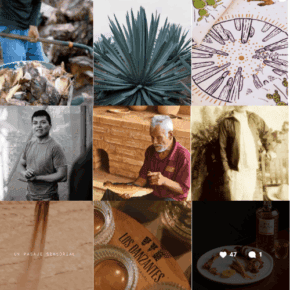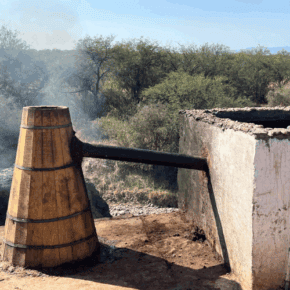
Editor’s note: I met Rachel Glueck last month as she hopped through San Francisco on on a tour to introduce her new mezcal, El Amor del Diablo, to the United States. It was a bit of a test mission to gauge local reaction and to gather steam for her crowdfunding campaign to really get her brand and much larger ambition to bring the mezcal they’ve sourced to the United States. She’s a great spokesperson for mezcal and, like any of us, has a unique story to tell. I’ll write more about her and El Amor del Diablo soon but I was so impressed by her story that I invited her to write about it for Mezcalistas. Here in her own words is her story, what she’s learned about mezcal and the native dancers who are one of the distillate’s original devotees.
—

From the south side of the border, modern mezcal culture can appear a bit…ridiculous. It’s all too easy to get swept away in the pizazz of mixologist magic, discussing for hours the flavor profiles of a Pierde Almas tepestate, all while admiring the particular curve of your fellow enthusiast’s moustache. Let’s face it: Mezcal has become a hipster drink. And that’s just fine, because this enthralling spirit deserves the attention and the respect it’s getting. Unfortunately, its essence often gets lost between the folds of industry talk. Mezcal, above all, is a sacred spirit – a gift for the people, from farmer to financier, hipster to hobo. To really know mezcal, you must know her for what she was from the beginning – what she still is to her native people: a shamanic medicine.
My husband, Noel Morales Meza, is well positioned to tell the story. A native of the mountains of Guerrero, he’s about as Mexican as they get. With his Nubian nose, big lips, and bull-like stance, he looks like he came straight out of the Olmec period. Morales grew up learning several native dances with the Diablos, the Tlacololeros, the Tigres, and the Huashkixtles. Today he is the leader of three Aztec dance groups in Mexico. Mezcal, he says, is an elemental part of the dance, regardless of what group you belong to.
In the state of Guerrero there are some 45 to 50 different types of dancers who come together for Mexico’s religious holidays – a complex blend of native and Catholic belief. Each group has a distinctive costume and a particular dance that portrays their story. The dance of the Tlacololeros symbolizes the planting of corn in the highlands and the farmer’s fight with the ocelot. The dance of the Diablos superficially represents the seven sins from the bible, but like most aspects of the native Mexican psyche, it developed as a means to keep indigenous traditions alive under the guise of Catholic belief. Far from being a submissive spirit, the role of mezcal in these groups, as you might imagine, has nothing to do with Catholic mass. Yet it is vitally important to the ritual of the dance.

“The old men of the dance drink mezcal to start the catharsis,” Noel tells me. “To start the dance you need to be in union with your character. You change your body, your energy, and your soul to be a jaguar, an alligator, a goat, a demon, an angel, or a crazy soul. You break the cacophony of life’s normal sounds. This magical union helps you to have the energy the dance requires.”
Mezcal is the catalyst to the shamanic connection of dancer to costume. It gives the dancers energy, cuts through their inhibitions, and connects them with their mask and costume. With mezcal the dancers forget about the people outside the mask. Noel tells me that dancers are “an element of the Energy Party, not an observer.”
Mezcal is also the fuel that keeps them going. Dances often begin before dawn and continue until late afternoon or past nightfall (or vice versa). With this medicine in the blood, the dancer doesn’t feel the dehydration, the extreme heat, or the pain. They don’t feel anything.
“Nothing?” I ask Noel incredulously. “Like they’re dead?” His face lights up – a man who’s finally found the words to express that spectral state he’s experienced so many times before. “Yes! Your body is dead because your costume is alive.”
“The hangover must be incredible,” I muse. Regardless of how pure a mezcal is, ten hours of dancing induced by large amounts of alcohol will ravage the system. “No manches!” he cries, reeling back. “It’s terrorific. But the hangover is also the time to pay the price for opening your soul and becoming an animal or a spirit.”
These dances aren’t merely about worshiping a patron saint, or celebrating a holiday. The dancers give their bodies over to practice for a multitude of reasons: for pleasure, for pride, for a sense of identity, to connect with their ancestors, and to pay the price for favors and miracles.
Every July, in the town of Mochitlan, Guerrero, where Noel’s mother was born, there is a festival to celebrate the patron saint, Señora Santa Ana. Overnight, the streets of this tiny village fill with 4,000 people, 25 different types of dance groups, thousands of fireworks, and liters and liters of mezcal. Each year, four or five families volunteer to provide the food, sacrificing and cooking up their finest bulls into huacashtoro (a mestizo beef stew), along with barbacoa, atole, tamales, beans and tortillas. For three days both the food and the mezcal are free for anyone and everyone.

“The mezcal is for everyone at the dance,” Noel says. “It makes a union for people to forget their social role: no poor, no rich, no brown, white, or Indian. Only people who believe in a common thing: a saint, a ritual, a tradition.”
In the streets, great swaths of people come together to watch and participate in the dance. A wave of colorful headdresses, demonic masks, jaguars, and machetes billow in the sultry space between bodies, as bottles of mezcal are passed between friends and strangers. Doctors, farmers, shopkeepers, professional drunkards, and government officials are shoulder-to-shoulder, swaying, laughing, releasing. The dancers are privileged to the otherworldly transformation, but all who partake in the alchemical elixir of maguey experience a catharsis.
—
Noel and Rachel only have a few days left in their crowdfunding campaign with the goal of creating an association of ancestral mezcal producers that preserves the craft, culture, and communities of mezcaleros. Learn about their vision, help fund their project, and get insider’s access to the world of mezcal through their rewards.












[…] Aztec dancer for 20+ years and leader of 3 different groups in the country. As you may have read in my article of mezcalistas.com, mezcal plays in an integral role as a shamanic medicine for native dancers). The next night we […]